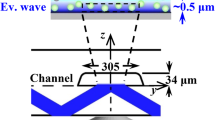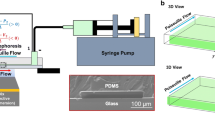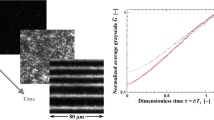Abstract
Colloidal particles may be repelled from/attracted to the walls of glass micro-channels when an electro-osmotic flow is combined with a Poiseuille flow. Under certain conditions, the particles assemble into bands after accumulating near the walls (Cevheri and Yoda in Lab Chip 14(8):1391–1394, 2014). The fundamental physical mechanisms behind these phenomena remain unclear and up to now only measurements within \(1\,\upmu \hbox {m}\) of the walls have been available. In this work, we applied a 3D particle-tracking technique, astigmatism particle tracking velocimetry, to measure the concentration and velocity distribution of particles across the depth of the entire micro-channel. The experiments show that the particles are depleted in the bulk as they become concentrated near the bottom and top walls and this particle redistribution depends strongly upon the bulk particle concentration. The results suggest that bands form in a region where particles are practically immobile and their volume fraction increases at least an order of magnitude with respect to the original volume fraction. Our results suggest that particle accumulation and band formation near the walls may be triggered by forces generated in the bulk since the banding and particle accumulation extends at least a few \(\upmu \hbox {m}\) into the channel, or at length scales beyond the range of surface forces due to wall interactions.









Similar content being viewed by others
Notes
Note that different shear rates could yield different particle distributions and therefore different forces. The value of such forces could in principle be obtained assuming that the particles are distributed following Boltzmann distributions. However, this implies that particles are in thermodynamic equilibrium, which is clearly not the case in our experiments. For that reason, we decide to restrict these studies to a single shear rate and explore the particle distribution in depth. Analysis and discussion on the effect of different shear rates can be found in recent publications (Yee and Yoda 2018).
References
Anderson JL (1989) Colloid transport by interfacial forces. Ann Rev Fluid Mech 21(1):61
Arca M, Butler JE, Ladd AJ (2015) Transverse migration of polyelectrolytes in microfluidic channels induced by combined shear and electric fields. Soft Matter 11(22):4375
Asmolov ES, Dubov AL, Nizkaya TV, Harting J, Vinogradova OI (2018) Inertial focusing of finite-size particles in microchannels. J Fluid Mech 840:613
Baygents J, Baldessari F (1998) Electrohydrodynamic instability in a thin fluid layer with an electrical conductivity gradient. Phys Fluids 10(1):301
Besseling R, Isa L, Ballesta P, Petekidis G, Cates M, Poon W (2010) Shear banding and flow–concentration coupling in colloidal glasses. Phys Rev Lett 105(26):268301
Bruus H (2008) Theoretical microfluidics. Oxford University Press, New York
Caserta S, Simeone M, Guido S (2008) Shear banding in biphasic liquid–liquid systems. Phys Rev Lett 100(13):137801
Cevheri N, Yoda M (2013) Evanescent-wave particle velocimetry measurements of zeta-potentials in fused-silica microchannels. Electrophoresis 34(13):1950
Cevheri N, Yoda M (2014a) Using shear and direct current electric fields to manipulate and self-assemble dielectric particles on microchannel walls. J Nanotechnol Eng Med 5(3):031009
Cevheri N, Yoda M (2014b) Electrokinetically driven reversible banding of colloidal particles near the wall. Lab Chip 14(8):1391–1394
Cevheri N, Yoda M (2014c) Lift forces on colloidal particles in combined electroosmotic and Poiseuille flow. Langmuir 30(46):13771
Chang MH, Ruo AC, Chen F (2009) Electrohydrodynamic instability in a horizontal fluid layer with electrical conductivity gradient subject to a weak shear flow. J Fluid Mech 634:191
Cherukat P, McLaughlin JB (1994) The inertial lift on a rigid sphere in a linear shear flow field near a flat wall. J Fluid Mech 263:1
Choudhary A, Renganathan T, Renganathan S (2018) Bulletin of the American Physical Society, Division of Fluid Dynamics (G24.00009)
Cierpka C, Segura R, Hain R, Kähler CJ (2010a) A simple single camera 3C3D velocity measurement technique without errors due to depth of correlation and spatial averaging for microfluidics. Meas Sci Technol 21(4):045401
Cierpka C, Rossi M, Segura R, Kähler CJ (2010b) On the calibration of astigmatism particle tracking velocimetry for microflows. Meas Sci Technol 22(1):015401
Cox R, Brenner H (1968) The lateral migration of solid particles in Poiseuille flow-I theory. Chem Eng Sci 23(2):147
Goldman AJ, Cox RG, Brenner H (1967a) Slow viscous motion of a sphere parallel to a plane wall-I motion through a quiescent fluid. Chem Eng Sci 22(4):637
Goldman A, Cox R, Brenner H (1967b) Slow viscous motion of a sphere parallel to a plane wall-II Couette flow. Chem Eng Sci 22(4):653
Ho B, Leal L (1974) Inertial migration of rigid spheres in two-dimensional unidirectional flows. J Fluid Mech 65(2):365
Hu Y, Glass J, Griffith A, Fraden S (1994) Observation and simulation of electrohydrodynamic instabilities in aqueous colloidal suspensions. J Chem Phys 100(6):4674
Isambert H, Ajdari A, Viovy JL, Prost J (1997) Electrohydrodynamic patterns in charged colloidal solutions. Phys Rev Lett 78(5):971
Israelachvili JN (2011) Intermolecular and surface forces. Academic Press, Cambridge
Jeffrey RC, Pearson J (1965) Particle motion in laminar vertical tube flow. J Fluid Mech 22(4):721
Keh HJ, Ding JM (2002) Electrophoretic mobility and electric conductivity of suspensions of charge-regulating colloidal spheres. Langmuir 18(12):4572
Kim YW, Yoo JY (2009) Axisymmetric flow focusing of particles in a single microchannel. Lab Chip 9:1043
Kirby BJ, Hasselbrink EF (2004) Zeta potential of microfluidic substrates: 1 theory, experimental techniques, and effects on separations. Electrophoresis 25(2):187
Lele PP, Mittal M, Furst EM (2008) Anomalous particle rotation and resulting microstructure of colloids in AC electric fields. Langmuir 24(22):12842
Li D, Xuan X (2018) Electrophoretic slip-tuned particle migration in microchannel viscoelastic fluid flows. Phys Rev Fluids 3:074202
Lyklema J (1991) Fundamentals of interface and colloid science. Volume I: fundamentals. Elsevier, Amsterdam
Manz A, Effenhauser CS, Burggraf N, Harrison DJ, Seiler K, Fluri K (1994) Electroosmotic pumping and electrophoretic separations for miniaturized chemical analysis systems. J Micromech Microeng 4(4):257
Matas JP, Morris JF, Guazzelli É (2004) Inertial migration of rigid spherical particles in Poiseuille flow. J Fluid Mech 515:171
Migler KB (2001) String formation in sheared polymer blends: coalescence, breakup, and finite size effects. Phys Rev Lett 86(6):1023
Navaneetham G, Posner JD (2009) Electrokinetic instabilities of non-dilute colloidal suspensions. J Fluid Mech 619:331
Rossi M, Kähler CJ (2014) Optimization of astigmatic particle tracking velocimeters. Exp Fluids 55(9):1809
Russel WB, Saville DA, Schowalter WR (1989) Colloidal dispersions. Cambridge University Press, Cambridge
Sadr R, Yoda M, Zheng Z, Conlisk A (2004) An experimental study of electro-osmotic flow in rectangular microchannels. J Fluid Mech 506:357
Saffman P (1965) The lift on a small sphere in a slow shear flow. J Fluid Mech 22(2):385
Schasfoort RB (1999) Field-effect flow control for microfabricated fluidic networks. Science 286(5441):942
Segre G, Silberberg A (1961) Radial particle displacements in Poiseuille flow of suspensions. Nature 189(4760):209
Snoswell DR, Creaton P, Finlayson CE, Vincent B (2011) Electrically induced colloidal clusters for generating shear mixing and visualizing flow in microchannels. Langmuir 27(21):12815
Yariv E (2006) “Force-free” electrophoresis? Phys Fluids 18(3):031702
Yee A, Yoda M (2018) Experimental observations of bands of suspended colloidal particles subject to shear flow and steady electric field. Microfluidics Nanofluidics 22(10):113
Yuan D, Pan C, Zhang J, Yan S, Zhao Q, Alici G, Li W (2016) Tunable particle focusing in a straight channel with symmetric semicircle obstacle arrays using electrophoresis-modified inertial effects. Micromachines 7(11):195
Zeng L, Balachandar S, Fischer P (2005) Wall-induced forces on a rigid sphere at finite Reynolds number. J Fluid Mech 536:1
Acknowledgements
The authors acknowledge financial support by the American National Science Foundation Fluid Dynamics Program (CBET-1235799) and the Deutsche Forschungsgemeinschaft (KA1808/12 and KA1808/22).
Author information
Authors and Affiliations
Corresponding author
Additional information
Publisher's Note
Springer Nature remains neutral with regard to jurisdictional claims in published maps and institutional affiliations.
Electronic supplementary material
Below is the link to the electronic supplementary material.
Supplementary material 1 (MP4 3816 kb)
Supplementary material 2 (MP4 4980 kb)
Rights and permissions
About this article
Cite this article
Rossi, M., Marin, A., Cevheri, N. et al. Particle distribution and velocity in electrokinetically induced banding. Microfluid Nanofluid 23, 67 (2019). https://doi.org/10.1007/s10404-019-2227-9
Received:
Accepted:
Published:
DOI: https://doi.org/10.1007/s10404-019-2227-9




